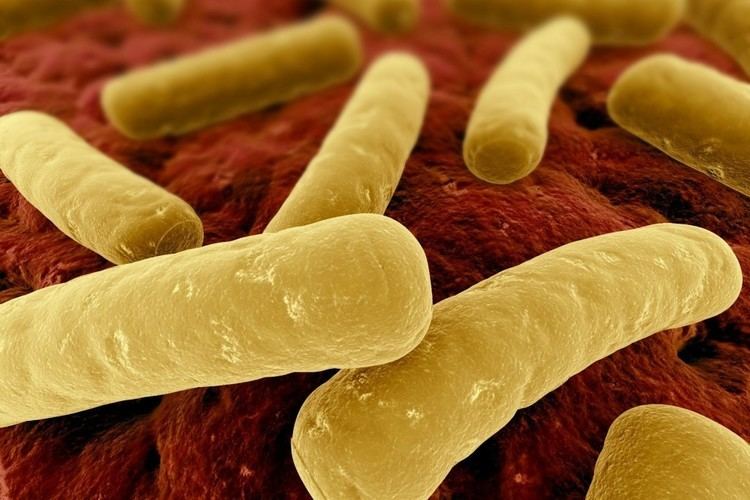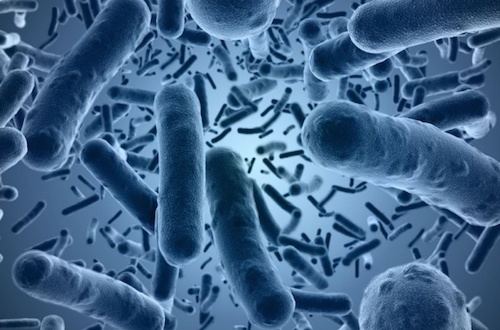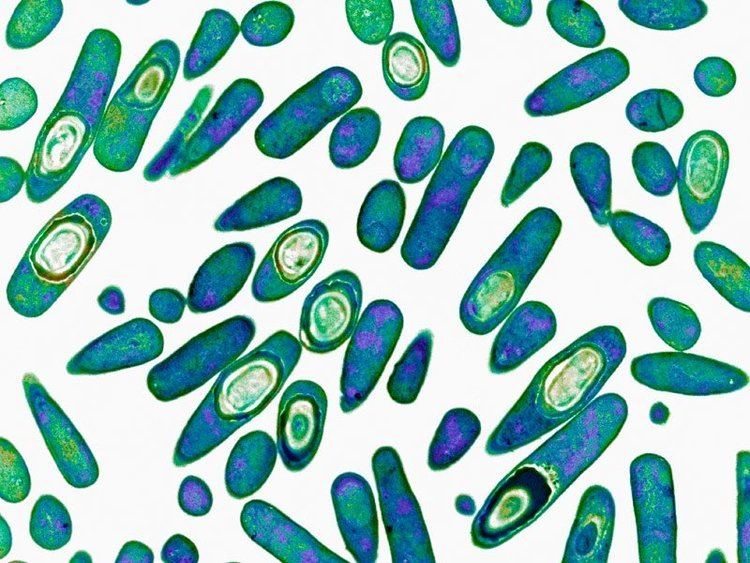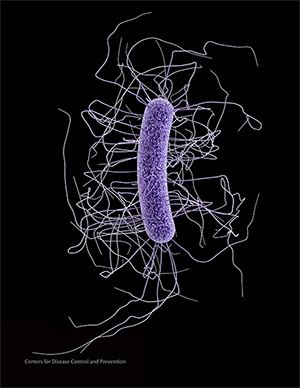Kingdom Bacteria Order Clostridiales Genus Clostridium Higher classification Clostridium | Phylum Firmicutes Family Clostridiaceae Scientific name Clostridium difficile Rank Species | |
 | ||
Similar Bacteria, Acinetobacter, Enterobacter, Proteus, Haemophilus | ||
Clostridium difficile (etymology and pronunciation), also known as C. difficile, C. diff (/siː/ /dɪf/), or sometimes CDF/cdf, is a species of Gram-positive spore-forming bacteria.
Contents

Clostridia (members of the genus Clostridium) are anaerobic, motile bacteria, ubiquitous in nature, and especially prevalent in soil. Under the microscope, they appear as long, irregular (often drumstick- or spindle-shaped) cells with a bulge at their terminal ends. Under Gram staining, C. difficile cells are Gram-positive and show optimum growth on blood agar at human body temperatures in the absence of oxygen. When stressed, the bacteria produce spores that are able to tolerate extreme conditions that the active bacteria cannot tolerate.

C. difficile may become established in the human colon; it is present in 2–5% of the adult population. Sometimes antibiotic therapy for various infections has the adverse effect of disrupting the normal balance of the gut flora, in which case C. difficile may opportunistically dominate, causing Clostridium difficile infection.

Human pathogen

Pathogenic C. difficile strains produce multiple toxins. The most well-characterized are enterotoxin (Clostridium difficile toxin A) and cytotoxin (Clostridium difficile toxin B), both of which may produce diarrhea and inflammation in infected patients (Clostridium difficile colitis), although their relative contributions have been debated. Toxins A and B are glucosyltransferases that target and inactivate the Rho family of GTPases. Toxin B (cytotoxin) induces actin depolymerization by a mechanism correlated with a decrease in the ADP-ribosylation of the low molecular mass GTP-binding Rho proteins. Another toxin, binary toxin, also has been described, but its role in disease is not fully understood.
Antibiotic treatment of C. diff infections may be difficult, due both to antibiotic resistance and physiological factors of the bacteria (spore formation, protective effects of the pseudomembrane). The emergence of a new, highly toxic strain of C. difficile, resistant to fluoroquinolone antibiotics, such as ciprofloxacin and levofloxacin, said to be causing geographically dispersed outbreaks in North America, was reported in 2005. The U.S. Centers for Disease Control (CDC) in Atlanta warned of the emergence of an epidemic strain with increased virulence, antibiotic resistance, or both.

C. difficile is transmitted from person to person by the fecal-oral route. The organism forms heat-resistant spores that are not killed by alcohol-based hand cleansers or routine surface cleaning, thus, these spores survive in clinical environments for long periods. Because of this, the bacteria may be cultured from almost any surface. Once spores are ingested, their acid-resistance allows them to pass through the stomach unscathed. They germinate and multiply into vegetative cells in the colon upon exposure to bile acids.
A 2015 CDC study estimated that C. diff afflicted almost half a million Americans and caused 29,000 deaths in 2011. The study estimated that 40 percent of cases began in nursing homes or community health care settings, while 24 percent occurred in hospitals.
C. difficile is actually quite common in the human digestive system. However, C. difficile is a poor competitor, and is often out competed by other bacteria for nutrients in the digestive system. As a result, C. difficile is kept to a manageable amount. If the sudden introduction of antibiotic disrupts the microbiome, C. difficile may be able to grow as a result of many of its competitors being killed off.
Strains
In 2005, molecular analysis led to the identification of the C. difficile strain type characterized as group BI by restriction endonuclease analysis, as North American pulse-field-type NAP1 by pulsed-field gel electrophoresis and as ribotype 027; the differing terminology reflects the predominant techniques used for epidemiological typing. This strain is referred to as C. difficile BI/NAP1/027.
Genome
The first complete genome sequence of a C. difficile strain was first published in 2005 by Sanger Institute in the UK. This was of the strain 630, a virulent and multiple drug-resistant strain isolated in Switzerland in 1982. Scientists at Sanger Institute have sequenced genomes of about 30 C. difficile isolates using next-generation sequencing technologies from 454 Life Sciences and Illumina.
Researchers at McGill University in Montreal sequenced the genome of the highly virulent Quebec strain of C. difficile in 2005 using ultra-high-throughput sequencing technology. The tests involved doing 400,000 DNA parallel-sequencing reactions of the bacterium's genome, which had been fragmented for sequencing. These sequences were assembled computationally to form a complete genome sequence.
In 2012, scientists at University of Oxford sequenced C. difficile genomes from 486 cases arising over four years in Oxfordshire using next-generation sequencing technologies from Illumina.
Bacteriophage
At least eight mainly temperate bacteriophages have been isolated from C. difficile, ranging in genome size from about 30 to about 60 kb. Both environmentally and clinically derived C. difficile strains carry a diverse and prevalent set of prophages.
Etymology and pronunciation
The species name is New Latin, from the Greek kloster (κλωστήρ), "spindle", and Latin difficile, "difficult, obstinate". It is pronounced /klɔːˈstrɪdiəm/ /dᵻˈfɪsᵻli/ in medical English (compare classical Latin /difˈfi.ki.leː/), although spelling pronunciations such as /ˈdɪfᵻsil/ and /dᵻfᵻsˈiːl/ are commonly heard. The latter two are approximately comparable to the pronunciations of the obsolete English adjective difficile and the French adjective difficile.
